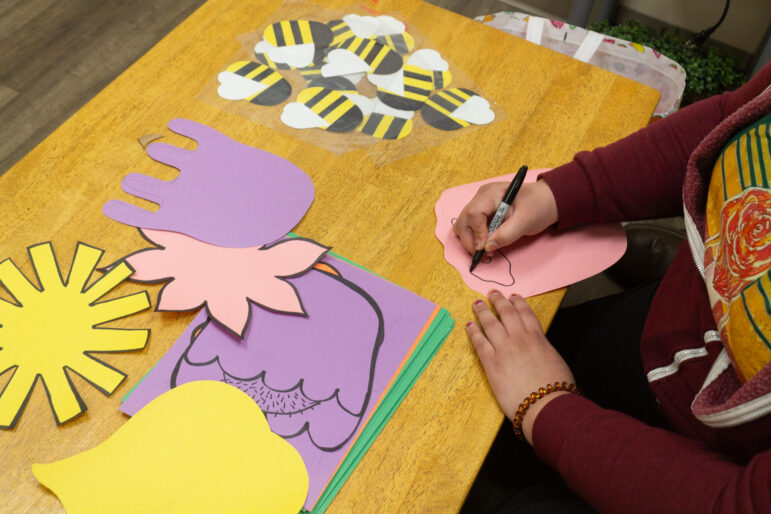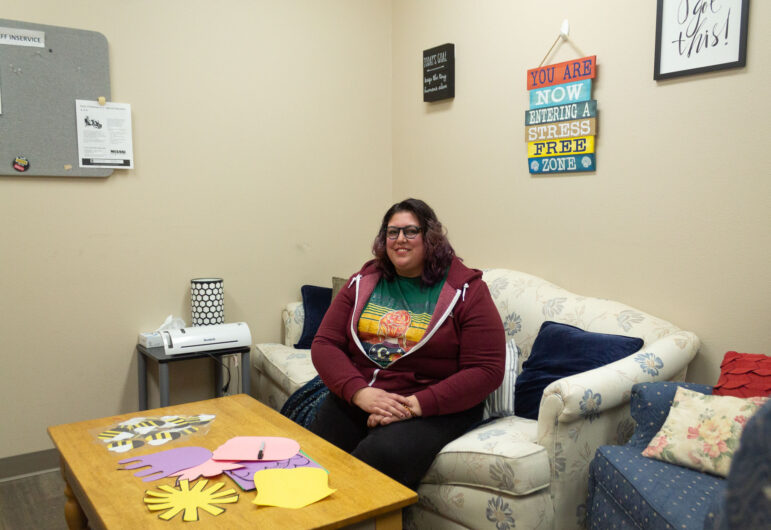
Amanda Maass is a childcare provider and involved with Kids Count On Us, a worker center dedicated to worker organizing and legislative protections for the essential workers.

Share
The mines of the Mesabi Iron Range gleam red under the light covering of snow that remains after a historically warm winter in northern Minnesota. Hibbing, a mining town of around 16 thousand people, bustles with industry. And in any town with working people, you’ll find the working people who make all other industries possible: the childcare workers.
Iron Range Tykes, a small childcare center in Mountain Iron, Minn., sits on a small hill just off Minnesota State Highway 33. There’s a fenced-in playground and a full parking lot. Amanda Maass, 34, a long-time childcare worker, has worked there for the past three years. It’s Transportation Week, and the children are learning about cars, trains, planes, helicopters, and hot air balloons. One teacher is setting out colorful paper and art supplies for the children to make their own hot air balloons.

Isabela Escalona
The Iron Range in Hibbing, Minn.Maass moved to the Iron Range, specifically Virginia, Minn., as the pandemic took hold over the Twin Cities area. A single mom with two daughters of her own, Maass was fearful as she saw the numbers of infections ticking up in the early days of the pandemic. She fondly remembered a vacation her family took up north during her childhood, and fulfilled a lifelong dream of moving somewhere outside the city, closer to the picturesque memory she held onto all those years.
Maass is a childcare teacher and involved with Kids Count On Us (an initiative of ISAIAH) a worker coalition dedicated to worker organizing and legislative protections for the essential workers. The coalition supports both the workers and the owners of small, independent childcare centers—who also suffer from overwork, low pay, and lack of sick-time.
Kids Count On Us and other community partners are advocating for two bills that would make childcare more affordable for low-income families. Although the bills are unlikely to pass due to insufficient funding in the legislature in the 2024 session, they propose that families below a certain income threshold would receive a childcare subsidy, supporting childcare centers in staying afloat while making childcare more accessible.

Isabela Escalona
Iron Range Tykes, a small childcare center in Mountain Iron, Minn., sits on a small hill just off Minnesota State Highway 33.Many childcare workers describe the push-and-pull between paying workers a fair wage and raising costs for families that are already struggling to pay. Currently, a family must earn $243,000 a year to pay no more than 7% of their annual income for just one infant in Minnesota, according to a report published by Kids Count On Us.
Maass spoke with Workday Magazine about her experiences living and working in greater Minnesota, the shift to a more rural life, and what she wants to see changed for childcare workers and the families they take care of. This interview has been edited for clarity and length.
Workday Magazine: Where do you live and how long have you lived there?
Maass: I live in Virginia, Minn. I moved up north from the metro area four years ago, in 2020 and I’ve been living in Virginia for two years now.
Workday Magazine: What made you move from the metro up north?
Maass: I was getting really scared of the Covid numbers. And I chose to jump on a dream. My family came up for a vacation, when I was eight or nine, and I just fell in love with the area. My whole life was trying to get up here. I was a preschool teacher at the time. I was only an assistant. The enrollment numbers were so low and they only needed the lead teacher, so I was laid off. I always say Covid was a blessing and a curse—I was laid off and miserable, but I was able to get those Covid paychecks. So I collected all those and was like, “You know what? Screw it. I’m living my dream.” So I moved.
Workday Magazine: It sounds like you’re enjoying living up north so far. What do you like so much about it?
Maass: I love it. I love the small town feel. I grew up in Maple Lake, with a population of two thousand people, mostly farmers. I was one of them. So I’m definitely a country mouse that was trapped in the city. I wanted to move to a town where it doesn’t feel like a city anymore. I just fell in love with it.
Workday Magazine: Why did you go to the Twin Cities metro initially?
Maass: I was in Buffalo, Minn. I kind of got trapped. I had gotten pregnant almost right out of high school and the dad of the baby lived there. So I ended up living with him. And then from there on out, I didn’t really make enough money to stretch and move anywhere else. So I was kind of stuck in that area.
Workday Magazine: Who do you live with now?
Maass: Just me and my two daughters—10 and 15.
Workday Magazine: How do they like living out there?
Maass: At first, my teenager was a little upset about it. It was a really tough move since it was during Covid and it was when the schools were shut down. She had a lifetime of friends that she didn’t even get a chance to say goodbye to and all her family and everything down there. She was 12 at the time that we moved. So she was a little upset about it, but I think she loves it now. We have a joke that anytime we’re driving around and we see something pretty we just yell out, “I love it here!” She’s been doing that so much more this year.
My younger one is all about adventures. Anytime it’s snow or sunshine, there’s always a place to explore up here and she just loves it.
Workday Magazine: So you currently work as a childcare teacher. How long have you been working there and how do you like it?
Maass: I just hit the three-year mark in November. I couldn’t picture myself anywhere else. I love it. I really love the support system. It really is like a family. Our boss works so hard. She doesn’t even like us calling her boss, I hesitate to call her that. But she tries so hard to make it feel like a family here. And it definitely is. I don’t feel like any of these girls are coworkers. They’re all sisters. Anytime I have anything to talk about, they’re the only ones I think of.
The families who bring their kids in here are just so appreciative. They understand the hardships throughout the day. They understand that we’re not paid very well. They bring us treats all the time, little gifts, and gift cards here and there when they can. Having that support from those families makes the kids appreciate you too. So the kids are fantastic. I have never seen a childcare so loving as this.

Isabela Escalona
Amanda Maass prepares an art activity before class.Workday Magazine: Is there an age range that you are taking care of?
Maass: Infant through 12 years of age. I’m personally in preschool most of the time.
Workday Magazine: What do you like about taking care of the preschoolers?
Maass: I love the stories they tell. I love watching the discovery in them. I help with infants every now and then to help out and I love being with the infants because you can watch them discover the world. But I love preschoolers because you can watch them discover the world and ask them about it. Then you can hear, in their words, what they think they’re discovering. When you teach them something new, they’re just like, “You are the smartest person in the world for knowing that.”
Workday Magazine: What’s the ratio of how many students there are to childcare providers?
Maass: The licensing ratio is supposed to be one teacher to 10 children. But one of the things I love about this center is that they are very good about supporting us and we usually have three teachers to 20 students in our room. That helps out so much.
When I first started working at a childcare, I wondered why are ratios like this? You’re not going to tell a mom with seven kids, “Tough luck, do it on your own.” I personally always thought that the ratios, licensing wise, should be adjusted. I really love that they appreciate that here and they make it so we can get prep time. They understand that when a kid has an accident, there’s got to be someone in the bathroom helping that kid and then the other teacher is left with 18 other kids. It’s gets to be a lot. That’s where a lot of the childcare working stress comes from. It’s just too much to put on one person.
Workday Magazine: What are other things you wish were different in the childcare industry?
Maass: Equality with teachers. It is a little frustrating knowing that the ages of one to five are the most important time to be teaching kids. So when people look at us and think that we’re just babysitters, it gets really frustrating.
Workday Magazine: What’s different about working in a rural childcare center compared with your experience working in the city?
Maass: I feel like being in a rural community makes it easier because we’re respected more. Because we’re needed more.
The city has a lot higher expectations. Where I was before, we were technically an early childhood education center. So we had to do math and writing. When I got here, I wondered why that wasn’t required. Because that was a big deal back in the city. So I feel like that’s good and bad, in a way. I did think they were pushing it too far in the cities.
In the rural areas, it’s not pushed as much and I feel like that’s a good thing. Because the kids just need to play. In farming towns, the families don’t care if the kids are in the dirt all day—if that’s how you’re teaching them to count, by counting rocks—that’s fine.
Workday Magazine: You mentioned that you started working in childcare so that you could access childcare for your daughter because it wasn’t affordable to you. Is that common with other childcare workers?
Maass: In my situation, I was stuck working overnight with my oldest. I worked overnights for eight years. The plan was to work overnights until my daughter got into school and then that’s when I had my second, so I was stuck working overnights for a long time, just because I didn’t have the option of childcare. Even when I applied for county assistance, the waitlists were a mile long or the county assistance wasn’t available for a certain amount of time. I feel like that’s a really common issue. The only reason I was able to get into the childcare was because they had an opening for my daughter, and I was able to bring her for free if I was an employee.

Isabela Escalona
Amanda Maass in the break room of the daycare center where she works.Workday Magazine: It sounds like then there’s also a lot of families not being able to afford childcare. Is that something you see at your childcare center, too?
Maass: We get that a lot. When we were speaking with the legislators about a childcare affordability bill. I don’t think anybody ever touches on the health aspect of it—that parents can’t afford childcare, or they get mad that they’re paying for childcare when their kids are sick, so sometimes they give their kid Tylenol and send them in anyways. They had to go to work and can’t afford to, or they already paid for the childcare.
It affects the health of everyone because then they bring in their kids while they’re sick. And it’s getting all the other kids sick and it’s getting teachers sick. We’re not paid enough to be able to afford days off or there’s such low numbers of employees that if you’re sick, you have to come in anyways.
Workday Magazine: It’s such a vicious cycle. You mentioned that you had been meeting with legislators recently. What kind of organizing are you doing to improve the conditions of childcare workers?
Maass: Yes, that was organized by my childcare center’s owner and she had just asked me to speak. There’s a bill that we’re trying to pass to make it where low-income families only pay 7% of their income for childcare, and then some of it is provided by the state. That way there’s more options for lower income families or people that are struggling to find childcare. Then childcare centers can apply for scholarships through the state and they’re trying to make that system a little bit easier too.
In the office, they are constantly filling out paperwork, just to try and keep up with the grants and scholarships that are keeping us alive right now. We don’t want to overcharge families, but in order to pay us fair wages, they would have to overcharge families. Right now, it’s over $200 a week to have an infant in our care. There’ve been quite a few families that I’ve heard of that just aren’t coming to childcare anymore and a family member stays home instead because they just can’t afford childcare.
Workday Magazine: Why is it important for you to be involved with the organizing that Kids Count On Us is doing?
Maass: I see the domino effect and how it affects the kids. It’s so sad to see. You can tell which kids go home to stressed parents and which ones are just fine. Usually it boils down to income. Being a low-income single mother myself, there’s so many things that my kids miss out on because I just can’t afford it or we don’t have time for it, because I’m working all the time. I can’t afford a day off or things like that. These are these little things that kids shouldn’t have to worry about.
My youngest is terrified to tell me when she doesn’t feel good. She’s 10—she should not be scared to tell me she doesn’t feel good. But she knows if she doesn’t feel well, I miss a day of work and I can’t afford to do something fun that week or we can’t get treats when we go grocery shopping. I know she’s not the only one, that kids are literally afraid to be sick. I don’t want kids to feel that way.
Workday Magazine: What do you wish more people knew about childcare workers?
Maass: I can’t tell you how many times people respond after I say I had a rough day, “You play with kids all day, and how hard is that?” These kids are constantly fighting, there’s paperwork. Teaching a kid to use scissors is scary enough in itself, but teaching 20 kids to use scissors at the same time? It’s pretty terrifying. It can get stressful.
I wish they could live a day in our life. I wish they understood how much more there is that goes into a day of taking care of kids.
__
This is the first story from the Greater Minnesota Worker Listening Project series, a new profile series on union and non-union workers in Greater Minnesota and other rural communities.

